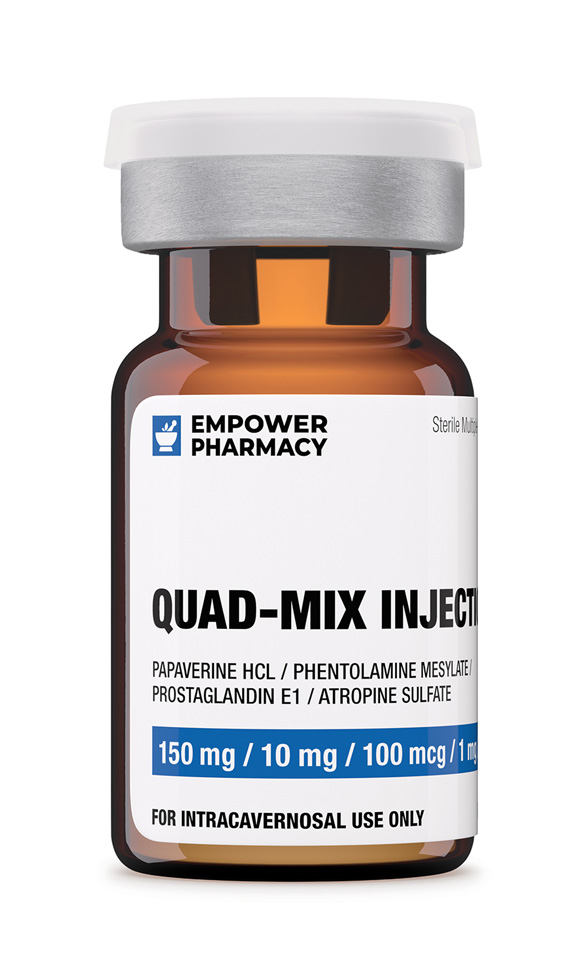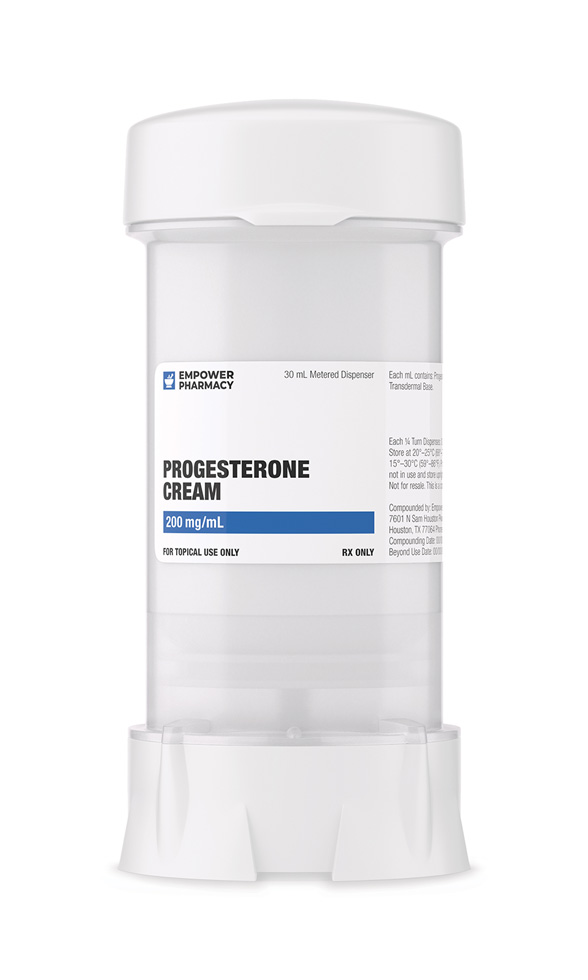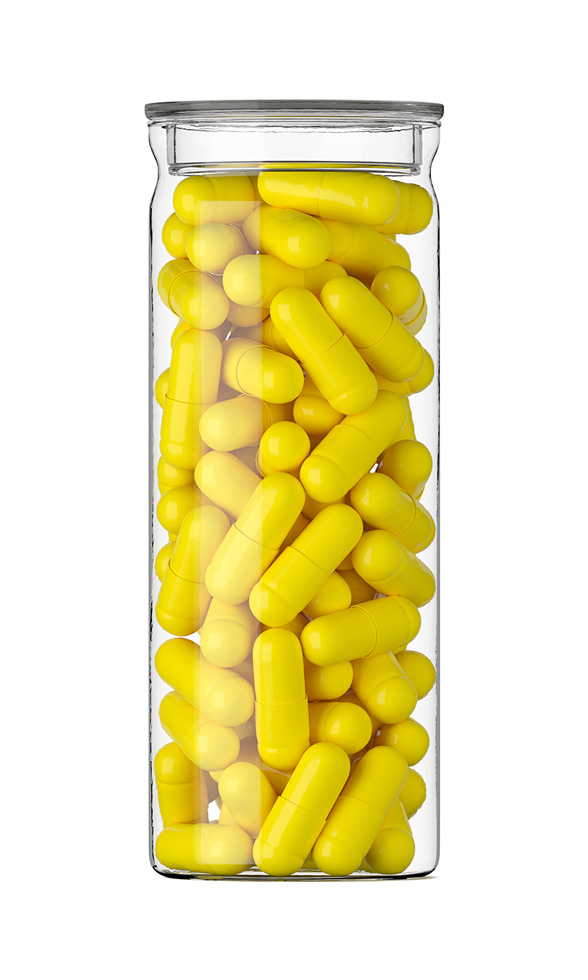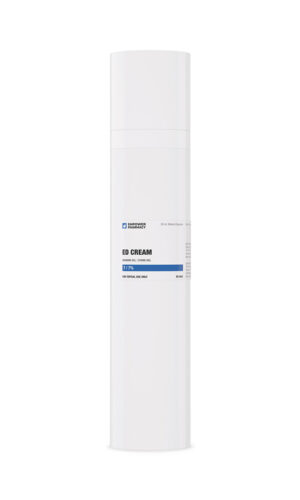- Description
- Reviews (0)
- Store Policies
- Inquiries
Description
Dosage Strengths of QuadMix Injection
QuadMiX Injection:
Papaverine HCl 150 mg, Phentolamine Mesylate 10 mg, Prostaglandin E1 100 mcg, Atropine Sulfate 1,000 mcg. Lyophilized.
Once reconstituted with 5 mL of Bacteriostatic Water: Papaverine HCl 30 mg/mL, Phentolamine Mesylate 2 mg/mL, Prostaglandin E1 20 mcg/mL, Atropine Sulfate 200 mcg/mL.
Super QuadMiX Injection:
Papaverine HCl 150 mg, Phentolamine Mesylate 20 mg, Prostaglandin E1 200 mcg, Atropine Sulfate 2,000 mcg. Lyophilized.
Once reconstituted with 5 mL of Bacteriostatic Water: Papaverine HCl 30 mg/mL, Phentolamine Mesylate 4 mg/mL, Prostaglandin E1 40 mcg/mL, Atropine Sulfate 400 mcg/mL.
QuadMix is administered as a penile self-injection, typically considered to be the most powerful class of anti-erectile dysfunction agents. While the components of QuadMix (Papaverine, Phentolamine, Prostaglandin E1, Atropine) are, on their own, indicated for a vast number of different conditions, the practice of bringing them together in concert to treat erectile dysfunction has become commonplace in sexual medicine and is now considered the go-to treatment if a patient is not responsive to conventional PDE5 inhibitors such as Viagra or Cialis. QuadMix is used in the treatment of erectile dysfunction in males. QuadMix contains four drugs from complimentary classes designed to act synergistically, mixed into a sterile injection. They are:
Papaverine HCl
A drug that causes blood vessels to expand (vasodilator); it produces an erection by allowing for increased blood flow to the penis. Papaverine interacts with adenylate cyclase resulting in increased cyclic adenosine monophosphate (cAMP) production, ultimately resulting in increased erectile capacity by relaxation of penile smooth muscle. This drug was one of the first effective therapies for erectile dysfunction administered by penile injection. Papaverine works by inhibiting phosphodiesterase nonspecifically, there are also multiple other mechanisms by which this drug acts to improve erectile capacity. The current body of medical literature has not established the predominant mechanism by which papaverine works. The multi-mechanistic manner by which this drug acts may be concentration dependent. Experimental data, performed in-vitro, displays papaverine acting to relax the penile arteries, the cavernosal sinusoids, and the penile veins. Experiments carried out in dogs display papaverine’s ability to decrease the resistance to arterial inflow while also increasing the resistance to venous outflow. Papaverine’s ability to decrease resistance to venous outflow has been replicated in clinical studies. A veno-occlusive mechanism may be responsible for the aforementioned findings.
Biweekly intracavernous administration of papaverine for erectile dysfunction.
Participants: 50 patients age 40 to 70 years old
Administration: intracavernosal injection at base of the penis
Dosage: 60 mg papaverine in 5 ml saline every 2 weeks
Results: Erection of 80% or more of normal was achieved by all but one patient, improves sexual potency
Medical treatment of impotence with papaverine and phentolamine intracavernosal injection.
Participants: 20 patients age 32 to 72 years old
Administration: intracavernosal injection
Dosage: 30 mg papaverine and phentolamine 1 mg
Results: Response with erection in 20- 30 minutes, phentolamine and papaverine produced an erection sufficient for intercourse in 18 of the 20 subjects
Treatment of impotence by intrapenile injections of papaverine and phenoxybenzamine: a double blind, controlled trial.
Participants: 39 patients age 27 to 67 years old
Administration: intracavernosal injection
Dosage: 60 mg Papaverine in 10 ml saline
Results: 35% full restoration of erectile capacity; 65% partial restoration of erectile capacity
Evaluating erectile dysfunction: oral sildenafil versus intracavernosal injection of papaverine:
Participants: 39 patients age 21 to 65 years old
Administration: intracavernosal injection
Dosage: 30 mg papaverine
Results: Papaverine improved length and circumference papaverine is effective as injection therapy for erectile dysfunction
Phentolamine Mesylate
When injected into the penis, it induces an erection by relaxing and dilating the blood vessels of the penis, as well as by elevating cardiac output.
Phentolamine is classified as an Alpha-Adrenoceptor Antagonists. Noradrenaline affects the smooth muscle tone of the penile tissues by keeping the corpora cavernosa in a contracted state. By blocking the functional noradrenaline receptors, the Alpha-Adrenoceptor, erectile response can be achieved. Phentolamine competes with endogenous norepinephrine for the Alpha1-Adrenoceptor and Alpha2-Adrenoceptor. Phentolamine has similar binding capacities to both receptors. The current literature suggests that this is the main mechanism by which phentolamine exerts its physiological effects. Phentolamine also blocks 5-HT receptors, inducing the release of histamine from mast cells. Some studies also show that NOS activation could possibly be involved in another mechanism, inducing increased vasodilation.
The Alpha-Adrenoceptor Antagonist of phentolamine is considered to be complex. The non-selective receptor blocking action interacts with adrenergic nerves in a complex fashion. Phentolamine action on adrenergic nerves has not been fully established. It is thought that there might be counteracting regulation on pre-and post-junctional nerves. It is not known how the counteracting regulation might affect the efficacy of phentolamine for the treatment of erectile dysfunction.
In animal studies, penile arterial inflow resistance was decreased. This proves in vivo that the physiological response to phentolamine acts in a manner to achieve erectile response. However, phentolamine has not displayed a significant effect on the venous outflow from penile tissues in humans. The current body of literature has not established pharmacokinetics for phentolamine.
First pass metabolism effectively reduces the efficacy in the treatment of erectile dysfunction. Therefore, this drug has to be administered by injection. The half-life of phentolamine is 30 minutes, with an effect duration of 2.5 to 4 hours. After penile injection the concentration of phentolamine in serum reaches a maximum within 20 to 30 minutes. After this amount of time has passed the drug rapidly is metabolized.
Side effects of phentolamine are rare. However, it has been reported that orthostatic hypotension, tachycardia, arrhythmias and myocardial infarction, have occurred after penile injection. The mechanism to which this set of side effects occur has not been rationally deduced through scientific study. Phentolamine is usually added in combination with papaverine or vasoactive intestinal peptide to increase erectile response.
Medical treatment of impotence with papaverine and phentolamine intracavernosal injection.
Participants: 20 patients age 32 to 72 years old
Administration: intracavernosal injection
Dosage: 30 mg papaverine and phentolamine 1 mg
Results: Response with erection in 20- 30 minutes, phentolamine and papaverine produced an erection sufficient for intercourse in 18 of the 20 subjects
Prostaglandin E1
A potent hormone-like substance that induces erection by relaxing penile blood vessels and dilating cavernosal arteries Dilation of the cavernosal arteries is accompanied by increased arterial inflow velocity and increased venous outflow resistance allowing for more blood into and less blood out of the penis.
Prostaglandin E1 is administered intracavernosally. This drug is prescribed as a second-line treatment, after oral PDE5 inhibitors have been ineffective for treatment of erectile dysfunction. Several aspects of its effects and clinical use have been reviewed previously. Currently the body of medical literature demonstrates that 40 to 70% of erectile dysfunction patients respond to treatment with prostaglandin E1. The demonstration that prostaglandin E1 with S-nitrosoglutathione in combination is more effective than prostaglandin E1 alone may shed light on the lack of efficacy in some patients.
Medications to activate alternative relaxant pathways in addition to by prostaglandin E1 may be necessary in patients who fail to respond to prostaglandin E1. Relaxation of smooth muscle is a critical component of erectile capacity. Additional agents to work in combination with prostaglandin E1 might have significant therapeutic benefits. Prostaglandin E1 with S-nitrosoglutathione or other erectile dysfunction medications, might have advantages in the treatment of male erectile dysfunction. Empower Pharmacy strives to compound medications that take advantage of multi-compound synergy. When injected into penile tissue prostaglandin E1 is readily metabolized into other erectile promoting molecules. These molecules potentiate the efficacy of prostaglandin E1. Prostaglandin E1 has been demonstrated to alter the concentrations of noradrenalin, adding a secondary mechanism of action. However, it is still believed prostaglandin E1 primarily acts directly by increasing cAMP synthesis via EP receptor interaction, increasing muscular relaxation.
Prostaglandin E1 has ubiquitous actions in controlling processes in many tissues. Known effects of prostaglandin E1 include systemic vasodilation, prevention of platelet aggregation, and ask to stimulate intestinal activity. Thus, prostaglandin E1 has very rarely been administered in a fashion to elicit a systemic response. Pharmacokinetics data is currently lacking on prostaglandin E1, the current data suggest short action duration and high rate of metabolic breakdown. After the first pass through the lungs 70% is metabolized. Because prostaglandin E1 is readily metabolized throughout the body, penile injection effects mainly penile tissues. Furthermore, this further explains the rare circulatory side effects.
Atropine Sulfate
Atropine sulfate has been used successfully in many studies in conjunction with vasoactive agents in the treatment of erectile dysfunction, when given as an intracavernosal injection.
Atropine sulfate works by inhibiting the nervous system receptors that control smooth muscle relaxation. Atropine sulfate is an anticholinergic agent that diminishes cholinergic inhibition of the adrenergic and cholinergic excitation of the nonadrenergic, noncholinergic neuroeffector systems that control neurogenic corporeal smooth muscle relaxation.
The mechanism of action also includes the release of endothelium derived relaxing factor, however this is more so involved at higher formal logical doses.
7-keto-DHEA is believed promote weight maintenance or loss by increasing resting metabolic rate.17 On a molecular level, studies in preclinical animal models showed that 7-keto-DHEA increased the activity of enzymes involved in thermogenesis, including mitochondrial and cytosolic sn-glycerol-3-phosphate dehydrogenase and cytosolic malic enzyme. It also increased the rate of mitochondrial substrate oxidation and the activity of enzymes involved in fatty acid oxidation, including liver catalase and fatty acyl-CoA oxidase.18 It is unknown how 7-keto-DHEA mediates these changes; however, it is believed the metabolites of 7-keto-DHEA, 7α-OH-DHEA and 7β-OH-DHEA, may be involved.318
Other effects of DHEA and 7-keto-DHEA, such as increased immune response, may also be mediated by 7α-OH-DHEA and 7β-OH-DHEA.23 Both 7α-OH-DHEA and 7β-OH-DHEA have been shown to inhibit the reduction of cortisone to cortisol in human skin; however, 7β-OH-DHEA was seven times more potent than 7α-OH-DHEA. Thus, it is possible that part of the physiological activity of 7-keto-DHEA and its metabolites is mediated by their ability to act as anti-glucocorticoids.19 However, given that cortisone and cortisol are present in substantially higher levels than 7α-OH-DHEA and 7β-OH-DHEA, these 7-keto-DHEA metabolites may not have a systemic effect, but they may act locally in tissues through autocrine or paracrine processes.
Do not take this medicine with any of the following medications: hypersensitivity or allergy to any component of this formulation; conditions predisposing you to priapism (painful erection lasting 4 hours or more): sickle cell anemia, multiple myeloma or leukemia; anatomical deformation of the penis or penile implants; direction by your physician that sexual activity is inadvisable or contraindicated. Tell your doctor if you have a condition or are taking a medicine that interferes with blood clotting.
Ideally, the injection should be administered just prior to foreplay. It is administered via intravavernosal injection and should produce an erection in 5 to 20 minutes and can be expected to last up to one hour. To prevent bruising, apply firm pressure to the injection site for 5 minutes after injecting. Do not use QuadMix Injection more than two times a week; use at least 24 hours apart. There is a possibility of needle breakage with use of QuadMix Injection: you should pay careful attention to your doctor’s instructions and handle syringe and needle properly.
Mild to moderate pain during injection; painful sensation with erection; small amount of bleeding at the injection site. Call your healthcare provider if you notice any redness, lumps, swelling, tenderness or curvature of the erect penis. If you experience an erection lasting more than 2 hours, you may take 2 – 4 pseudoephedrine 30 mg by mouth once and apply an ice pack.31 If your erection does not go away within the next hour, seek professional help immediately. Erections that last more than 6 hours can cause serious damage to the penile tissue.
Store this medication at 68°F to 77°F (20°C to 25°C) and away from heat, moisture and light. Keep all medicine out of the reach of children. Throw away any unused medicine after the beyond use date. Do not flush unused medications or pour down a sink or drain.
Learn how to prepare medication for self-administered injection.
1.Montague DK, Jarow JP, Broderick GA, et al. Chapter 1: The management of erectile dysfunction: an AUA update. J Urol 2005;174:230-9.
2.Leungwattanakij S, Flynn V, Hellstrom WJG. Intracavernosal injection and intraurethral therapy for erectile dysfunction. Urol Clin North Am 2001;28:343-354.
3.Andersson, K.E., Pharmacology of penile erection. Pharmacol Rev, 2001. 53(3): p. 417-50.
4.Virag, R., et al., Vasoactive intestinal polypeptide release during penile erection in man. Lancet, 1982. 2(8308): p. 1166.
5.K.E., A., Pharmacology of erection: agents which initiate and terminate erection. Sex Disabil 1994. 12: p. 53–79.
6.Kirkeby, H.J., et al., [Infusion cavernosography and erectile dysfunction]. Ugeskr Laeger, 1990. 152(24): p. 1724-6.
7.Juenemann, K.P., et al., Hemodynamics of papaverine- and phentolamine-induced penile erection. J Urol, 1986. 136(1): p. 158-61.
8.Delcour, C., et al., The effect of papaverine on arterial and venous hemodynamics of erection. J Urol, 1987. 138(1): p. 187-9.
9.Mooradian, A.D., et al., Biweekly intracavernous administration of papaverine for erectile dysfunction. West J Med, 1989. 151(5): p. 515-7.
10.Dinsmore, W.W., Medical treatment of impotence with papaverine and phentolamine intracavernosal injection. Ulster Med J, 1990. 59(2): p. 174-6.
11.Keogh, E.J., et al., Treatment of impotence by intrapenile injections of papaverine and phenoxybenzamine: a double blind, controlled trial. Aust N Z J Med, 1989. 19(2): p. 108-12.
12.Viswaroop, B., A. B, and G. Gopalakrishnan, Evaluating erectile dysfunction: oral sildenafil versus intracavernosal injection of papaverine. Natl Med J India, 2005. 18(6): p. 299-301.
13.Traish, A.M., et al., Expression of functional alpha2-adrenergic receptor subtypes in human corpus cavernosum and in cultured trabecular smooth muscle cells. Recept Signal Transduct, 1997. 7(1): p. 55-67.
14.Traish, A., et al., Phentolamine mesylate relaxes penile corpus cavernosum tissue by adrenergic and non-adrenergic mechanisms. Int J Impot Res, 1998. 10(4): p. 215-23.
15.Juenemann, K.P., et al., Hemodynamics of papaverine- and phentolamine-induced penile erection. J Urol, 1986. 136(1): p. 158-61.
16.Wespes, E., C. Rondeux, and C.C. Schulman, Effect of phentolamine on venous return in human erection. Br J Urol, 1989. 63(1): p. 95-7.
17.P.R., I., G. B., and B.L. . Human pharmacology of orally administered phentolamine, in Phentolamine in Heart Failure and Other Cardiac Disorders., in Proceedings of an International Workshop London, November 1975 T. S.H. and G. L.A., Editors. 1975, Hans Huber Publishers: Bern, Switzerland.
18.O, H., W. U, and K. U, Systemic pharmacokinetics of papaverine and phentolamine: comparison of intravenous and intracavernous application. Int J Impot Res, 1990. 2 (Suppl 2): p. 247–248.
19.Eardley, I., et al., Pharmacotherapy for erectile dysfunction. J Sex Med, 2010. 7(1 Pt 2): p. 524-40.
20.Dinsmore, W.W. and M.G. Wyllie, Vasoactive intestinal polypeptide/phentolamine for intracavernosal injection in erectile dysfunction. BJU Int, 2008. 102(8): p. 933-7.
21.Albersen, M., et al., Evaluation and treatment of erectile dysfunction. Med Clin North Am, 2011. 95(1): p. 201-12.
22.Linet, O.I. and F.G. Ogrinc, Efficacy and safety of intracavernosal alprostadil in men with erectile dysfunction. The Alprostadil Study Group. N Engl J Med, 1996. 334(14): p. 873-7.
23.Porst, H., The rationale for prostaglandin E1 in erectile failure: a survey of worldwide experience. J Urol, 1996. 155(3): p. 802-15.
24.Angulo, J., et al., Rationale for the combination of PGE(1) and S-nitroso-glutathione to induce relaxation of human penile smooth muscle. J Pharmacol Exp Ther, 2000. 295(2): p. 586-93.
25.Molderings, G.J., et al., Inhibition of noradrenaline release from the sympathetic nerves of the human saphenous vein by presynaptic histamine H3 receptors. Naunyn Schmiedebergs Arch Pharmacol, 1992. 346(1): p. 46-50.
26.Palmer, L.S., et al., Characterization of cyclic AMP accumulation in cultured human corpus cavernosum smooth muscle cells. J Urol, 1994. 152(4): p. 1308-14.
27.Golub, M., et al., Metabolism of prostaglandins A1 and E1 in man. J Clin Invest, 1975. 56(6): p. 1404-10.
28.Hall, S., et al., Use of atropine sulfate in pharmacologic erections: initial experience with one year follow-up in the United States. . 1992. part 2: p. part 2, 147: 265A.
29.Montorsi, F., et al., Long-term clinical reliability of transurethral and open prostatectomy for benign prostatic obstruction: a term of comparison for nonsurgical procedures. Eur Urol, 1993. 23(2): p. 262-6.
30.Montorsi, F., et al., Four-drug intracavernous therapy for impotence due to corporeal veno-occlusive dysfunction. J Urol, 1993. 149(5 Pt 2): p. 1291-5.
31.”Prostaglandin E1/Phentolamine/Papaverine Injection Patient Information”. The Compounding Center. Web.
Be the first to review “QuadMix Injection”
General Inquiries
There are no inquiries yet.










Reviews
There are no reviews yet.